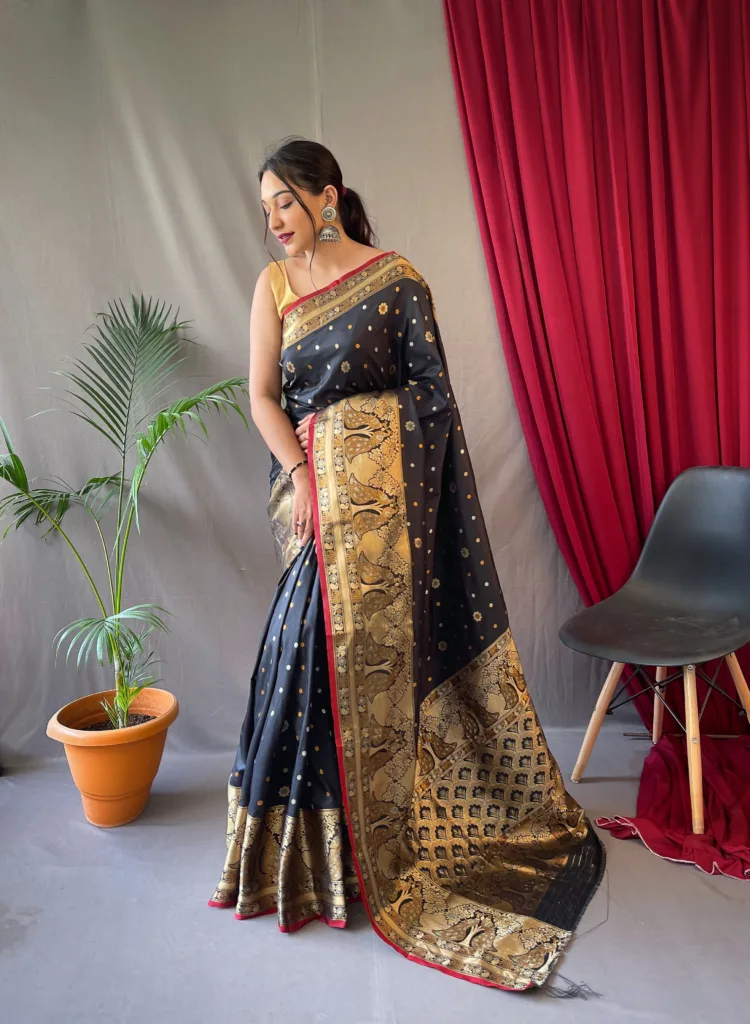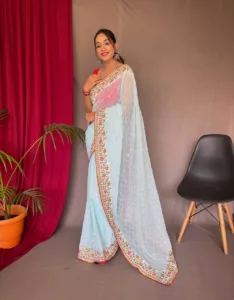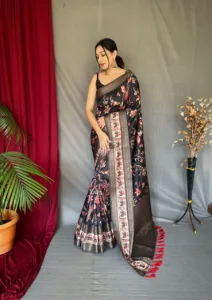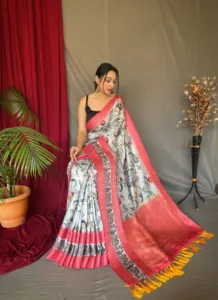FREE SHIPPING ON PREPAID ORDERS



Saree, the metaphorical gesticulation of womanhood in India, has a rich history that has evolved over the years. Although sarees are worn in many other South Asian countries like Bangladesh, Sri Lanka, Myanmar, etc., India remains at the top of the list of countries that wear sarees. Despite the influences of European and Middle Eastern fashion, the custom and civilization of wearing sarees remain intact in India.
The word “saree” originated from the Sanskrit word “Shati,” which means a chevron of cloth. Sarees are typically made of 4-9 meters of fabric, elegantly pleated around the waistline, highlighting the curves and creating a voluminous shape that is unique among all outfits.
Growing up in a family full of dynamic women who wore sarees regularly on every occasion, we were deeply impressed with this gorgeous national costume. Sarees bring out the best in you, regardless of age, and emit an aura of exceptional sophistication and charisma. Sarees are not just an ensemble for traditions and celebrations, but also an element of fashion creativity and an expression of culture and emotions that are treasured by every woman.
Each state in India has its own unique saree weaving method, making them memorable with their particular look and feel. With over 25 varieties in total, each saree from different regions of India exudes charisma. Let’s take a look at some traditional saree styles from India’s different states, listed in alphabetical order:
1. Ashavali Saree (Gujarat):
Ashavali sarees are known for their nature-inspired patterns on colourful silk, with a golden Zari background that adds to their aesthetic appeal. The prints and designs are outlined with a thin dark line, resembling mosaic work, which sets apart the thick and heavy Gujarati embroidery from other types of embroidery.
2. Baluchari Saree (West Bengal):
These magnificent silk pallu sarees are adorned with scenes from the mythological epics of Ramayana and Mahabharata. The square blocks on the border are decorated with embroidered designs. Swarnachari is a series of Baluchari sarees woven with zari fabric, which are a staple of West Bengal women. The intricate designs on Baluchari silk sarees require a lot of work, making them among the highest-priced sarees in the market.
3. Banarasi Saree (Uttar Pradesh):
Banarasi sarees are known for their rich and heavy texture, with designs inspired by Mughal art. They usually feature leaves, gold weave, human figures with intricate details, metallic graphical effects, and beautiful vertical leafy patterns that form the outer edge of the saree. There are varieties such as Tanchoi, Jangla, Cutwork, Butidar, and Vaskat in silk, organza, and georgette.
4. Bandhani Saree (Rajasthan):
Bandhani sarees, also known as Bhandej saree, are made using a special tie and dye technique in which the saree is tied with buttons, and then colors are splattered onto the fabric. The knots prevent the colors from spreading, creating a unique look. Bandhani sarees are known for their bright colors and beautiful polka dot imprints. The more detailed the design with a higher number of stitches, the more expensive the Bandhani saree will be.
5. Batik Saree (West Bengal)
Batik saree from West Bengal are known for their simple yet outstanding designs. They are created using a traditional craft called batik, which involves dyeing fabric by coating a part of it with wax. The waxed areas retain the original color of the fabric, resulting in a dyed and smudge-free contrast, giving it a fresh and eye-catching pattern. These sarees are adorned with picturesque designs on colorful canvases, making them highly attractive. Batik artisans showcase their creativity by using dyes and waxes on various natural fabrics such as cotton, silk, and more.
6. Bomkai Saree (Orissa)
Bomkai sarees from Orissa are known for their ethnic appeal and intricate patterns. They are inspired by tribal art and the natural environment, featuring rare interwoven motifs of turtles, ancient fish, lotus flowers, peacocks, birds, and more on a background dyed in red, white, and black. The designs on Bomkai sarees are left to the creativity of the weaver’s thought, choice, and perception. The process used to create the patterns is known as the Jala technique, which results in unique and artistic designs that are a true representation of the rich culture and heritage of Orissa.
7. Chanderi Saree (Madhya Pradesh)
Chanderi sarees from Madhya Pradesh are known for their light texture and lustrous transparency. They are made from pure silk, fine cotton, and zari, making them one of the lightest saree fabrics in India. These beautiful sarees are printed with signature figures and designs inspired by nature, such as swans, trees, fruits, flowers, peacocks, celestial bodies, gold coins, and animals. The intricate designs and exquisite craftsmanship make Chanderi sarees a popular choice for special occasions and events, adding a touch of elegance and grace to any wardrobe.
8. Chikan Saree (Uttar Pradesh)
Chikan sarees from Uttar Pradesh are known for their delicate and intricate embroidery work. Originally developed on white chiffon, Chikan embroidery is now done on a variety of fabrics using a colorful palette. The embroidery work on Chikan saree is famous for its various effects created using different types of threads and stitches, resulting in marvellous and artistic designs. These sarees are a pure definition of sophistication and magnificence, with their light textures, soothing colors, and stylish adornments such as sequins. They are suitable for any occasion, be it casual or formal, and are a symbol of elegance and finesse.
9. Dharmavaram Saree (Andhra Pradesh)
Dharmavaram sarees from Andhra Pradesh are known for their heavy “pallus” and exclusive designs. These sarees bear a striking resemblance to Kanjeevaram saree, but their bright colors and dual shades create a unique effect that makes them a must-have for any saree collection. Dharmavaram silk sarees are highly sought-after and popular as wedding saree, known for their rich and luxurious appearance. The heavy “pallus” and intricate designs make them a symbol of elegance and grandeur, perfect for special occasions and celebrations.
10. Eri Silk Saree (Assam)
Eri silk sarees from Assam are also known as Ahimsa (Nonviolent Silk) or Peace Cloth, as they are obtained without killing the silkworm. Eri silk is considered India’s best and most purified silk, produced by the worm Samia Cynthia Ricini. These sarees are characterized by their richer and darker appearance compared to other
11. Guntur Saree (Andhra Pradesh)
Known for their delicate curtains and stable weave construction, Guntur sarees are made from cotton and feature distinctive Ikat-style weaves such as checks and gold stripes. These sarees are known for their comfort and ease of wearing, making them perfect for everyday wear.
12. Garad Saree (West Bengal)
Garad sarees are made from silk that has not been dyed, symbolizing purity. They are characterized by their off-white or cream background with red or brown trim and small floral designs. Garad sarees are often worn on special occasions in West Bengal, and are considered important for Bengali women.
13. Ilkal Saree (Karnataka)
Ilkal sarees are known for their unique weaving technique, which combines cotton for the warp and art silk or pure silk for the pallu and border. The main body of the saree features tartan, square, striped, or rectangular patterns, while the pallu has vertically running colored stripes with patterns inspired by temple architecture.
14. Jamdani Dhakai Saree (West Bengal)
Jamdani Dhakai sarees are known for their lightness and fine craftsmanship. The patterns on these sarees appear to float on the surface of the ultra-fine fabric, creating a magical charm. They are hand-woven with gold thread and feature rich patterns and motifs in matching shades that contrast with the cotton or silk base fabric. Jamdani Dhakai saree is considered one of the finest muslin fabrics in the world.
15. Kalamkari Saree (Andhra Pradesh)
Kalamkari sarees are known for their unique craftsmanship. The patterns on these saree are outlined using tamarind branches and painted with natural plant dyes. The patterns often depict scenes inspired by Hindu mythology, ancient caves, and carvings. One of the unique features of Kalamkari sarees is that the colors and patterns become more vibrant with each wash, making them even more beautiful over time.
16. Kanjeevaram Saree (Tamil Nadu)
Kanjeevaram sarees are known for their luxurious texture and vibrant colors. They are crafted with precision and care, using fine mulberry yarns. The sarees are characterized by their contrasting borders with ethnic South Indian nuances, which add to their regal appearance. These are highly sought after for their excellent texture, shine, durability, and smoothness, and are often worn on special occasions and weddings in Tamil Nadu.
17. Kasavu or Balarampuri Saree (Kerala)
Kasavu sarees are known for their gold embroidery along the edges, but they have diversified over time to include colors and man-made fibers. These ethnic saree from India are loved for their traditional nature, featuring natural prints such as birds and flowers with golden borders. They are hand-woven with fine unbleached cotton fabric.
18. Kota Saree (Rajasthan)
Woven on traditional looms, Kota sarees are transparent even when made with cotton and silk threads. These are extravagant and long-lasting, thanks to the shiny texture of silk and the durability of cotton. These are known for their geometric embroidery, chequered patterns, and fringe patches, making them unique and exclusive.
19. Lehariya Saree (Rajasthan)
These are simpler to make compared to the complicated Bandhej technique. The only difference is in the way the fabric is tied during the dyeing process. In Lehariya type, opposite ends along the length of the fabric are pulled and rolled together, then knotted and brightly colored to create multicolored diagonal lines with a kaleidoscope design.
20. Mangalgiri Saree (Andhra Pradesh)
Mangalgiri sarees are perfect for saree lovers who prefer a neat and flawless look. These are traditional and simple cotton sarees, hand-woven with combed yarn and densely woven, giving them a stylish appeal with a crisp pleat.
21. Narayanpet Saree (Telangana)
Narayanpet sarees showcase the amalgamation of Telangana and Maratha styles, resulting in a visually appealing saree with intricate ethnic patterns on the chequered embroidered surface, border, or pallu. These hand-woven saree create a contrasting look with detailed zari patterns.
22. Paithani Saree (Maharashtra)
Paithani sarees are hand-woven using high-quality silk and feature a combination of lushness and richness. These types come in vibrant colors with a slanted border design and natural motifs imprinted on the pallu, adding to their lively allure.
23. Patola Saree (Gujarat)
Patola sarees are regal pure silk sarees that are hand-dyed with natural dyes, making them quite expensive and niche. These sarees are known for their double ikat weaving, creating identical designs on both sides in terms of color intensity, feel, and texture.
24. Sambalpuri Saree (Odisha)
Sambalpuri sarees are made from delicate weaving of various methods of silk and soft cotton. These hand-woven sarees are known for their unique embroidery designs, comfort, and durability, making them suitable for everyday wear, whether it’s for household chores or office work.
25. Tant Saree (West Bengal)
Tant sarees are woven from lightweight and transparent cotton threads, making them ideal for everyday wear. These crispy cotton sarees are seasoned with flour, giving them a precise crepe look and making them one of the most comfortable sarees for daily wear. They are made using traditional Bengali cotton with short threads.
26. Uppada Saree (Andhra Pradesh)
Uppada sarees are luxurious and translucent sarees that are hand-woven using the centuries-old Jamdani method. Made from cotton, these sarees have made a significant contribution to the Indian textile industry. They are known for their grandeur, lightness, and elegant patterns, including floral prints and geometric designs.
27. Venkatgiri Saree (Andhra Pradesh)
Venkatgiri Sarees are renowned for their silk or cotton jamdani weaving style. These sarees are known for their softness, durability, smoothness, lightness, and royal texture, which have made them famous worldwide.
Originally worn by the Nellore royal family in the 1700s, Venkatgiri saree is six meters in length and are suitable for all climates due to their smooth texture. The weavers of Venkatgiri are known for their expertise in creating exclusive saree and are willing to develop it based on your stylistic ideas.
The saree is the oldest surviving costume in the world and is an integral part of Indian culture that continues to thrive despite modernization. This article aimed to provide readers with a brief overview of the various saree varieties found across India.




